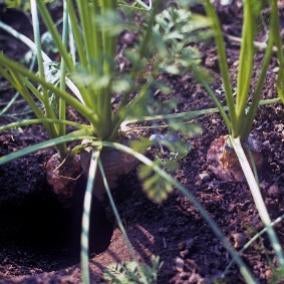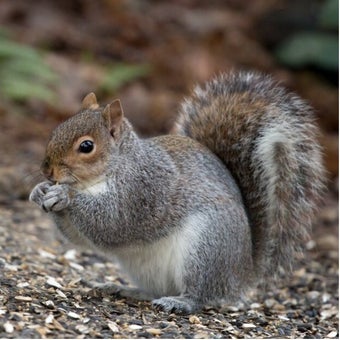
Quick facts
Common name - Brown rat
Scientific name - Rattus norvegicus
Plants affected - Vegetables, especially root crops, sweetcorn and stored fruits
Main cause - Rats eating growing and stored crops
Timing - All year round
What are rats?
Rats are rodents that are widely distributed and common in Britain, occuring in the countryside and urban areas. They are highly social and adaptable mammals and feed on a wide variety of foods. They can make their homes underground or in heaps, in buildings, greenhouses, sheds or drains.
Appearance
Rats are adaptable creatures that can eat a very wide range of foodstuffs. In gardens they will feed on sweetcorn cobs, pumpkins and squash and various root vegetables, such as carrot, parsnip, beetroot and potato tubers. This feeding can occur while the crops are growing and when they are being stored. Harvested fruits, such as apples, can be similarly damaged. Seeds can also be consumed. They can become regular visitors to bird feeding stations. Rats will also prey upon invertebrates including snails, a pile of snail shells is often a sign that rats have been present.
Parallel grooves, where a rat's incisor teeth have bitten into the food material, are usually visible. Rat tunnels in the soil have an entrance diameter of 30-40 mm, about twice that created by mice or voles. Rat droppings may be visible where feeding has occurred. The pellets are cylindrical in shape with rounded ends and are about 15 mm long and 5 mm wide when fresh, again about twice the size of mice or vole droppings. Adult rats are about 21 cm long with relatively hairless tails that add another 18 cm to the animal's length.

The problem
Rats can feed on the fruit and vegetables that we intend to eat, either while it is growing or after it has been harvested and is being stored. Rats will take food provided for wild birds, poultry and pets. Rats often carry a bacteria that can infect people, causing a form of jaundice known as leptospirosis or Weil's (pronounced 'Viles') disease (NHS information). The bacterium is spread in rats' urine and can persist in wet places. It infects people through cuts and abrasions or by ingestion. The risks can be minimised by taking some simple precautions listed here.
Rats have a liking for heaps, the light friable nature of the compost is ideal for burrowing. Compost that has come from a bin or heap that rats have lived in can be used in the garden but avoid using it on fruits or vegetables that are going to be eaten raw and the edible parts may be in contact with the soil or compost e.g. radish, celery, cucumber and strawberry.
Management
Discourage rats by removing any accessible food sources, for example by making sure bins are sealed. When feeding wildlife such as birds, do not let excess food build up (this will also help reduce the risk of spreading wildlife diseases). Removing clutter will reduce hiding and nesting places for these animals. More information on living with rats can be found in the RSPCA living with series.
Biology
Rats have complex social structures and are adaptable and intelligent animals. They breed all year with females having up to five litters a year. The average litter has seven young but as many as 14 have been recorded. More information on these animals from the mammal society.







